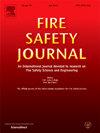On gravity-driven liquid nitrogen jets reach and horizontal spread for extinction of ground fires by aerial means
IF 3.4
3区 工程技术
Q2 ENGINEERING, CIVIL
引用次数: 0
Abstract
This paper describes experimental and numerical results on the reach and the spread of gravity-driven jets of liquid nitrogen (LN2) on the ground for applications to fire extinction by aerial means. A series of experiments released LN2 jets from different elevations in ambient air to measure their reach and spread distances upon the impingement. A numerical model was developed to simulate the behavior of such jets. Upon validation, the numerical model was used to further predict the LN2 pool mass and spreading distances under various release configurations. Results showed that the LN2 survivability is greatly affected by the release height of the cryogen, since the LN2 quantity reaching the ground decreases as the release height increases. Moreover, releasing larger initial LN2 quantities and, most importantly using larger nozzle diameters, both the LN2 pool mass and spreading diameter can be extended. Additional experiments were conducted where cryogen jets were released onto small (∼300 cm2) alcohol pool fires; results showed that only limited quantities of the LN2 evaporated in transit to the fire, and small amounts of the cryogen expediently snuffed the fires. A simplified model also suggested that in fire supression/extinction by LN2 the fuel cooling mechanism is of secondary importance compared to the mechanism of separating the fuel from oxygen.
关于重力驱动液氮喷射器的射程和水平传播,以空中手段扑灭地面火灾
本文介绍了应用于空中灭火的液氮(LN2)重力驱动喷射流在地面的到达和传播距离的实验和数值结果。一系列实验从不同高度在环境空气中释放液氮射流,以测量其撞击后的射程和扩散距离。开发了一个数值模型来模拟这种射流的行为。经过验证后,该数值模型被用于进一步预测各种释放配置下的 LN2 池质量和扩散距离。结果表明,由于到达地面的 LN2 量随着释放高度的增加而减少,因此 LN2 的存活率在很大程度上受到低温释放高度的影响。此外,释放更大的初始 LN2 量,最重要的是使用更大的喷嘴直径,可以扩大 LN2 池质量和扩散直径。还进行了其他实验,向小型(∼300 平方厘米)酒精池火灾释放低温喷射物;结果表明,只有有限数量的 LN2 在运往火灾现场的途中蒸发,少量低温物质可迅速扑灭火灾。一个简化模型还表明,在利用 LN2 抑止/扑灭火灾的过程中,燃料冷却机制与燃料与氧气分离机制相比是次要的。
本文章由计算机程序翻译,如有差异,请以英文原文为准。
求助全文
约1分钟内获得全文
求助全文
来源期刊

Fire Safety Journal
工程技术-材料科学:综合
CiteScore
5.70
自引率
9.70%
发文量
153
审稿时长
60 days
期刊介绍:
Fire Safety Journal is the leading publication dealing with all aspects of fire safety engineering. Its scope is purposefully wide, as it is deemed important to encourage papers from all sources within this multidisciplinary subject, thus providing a forum for its further development as a distinct engineering discipline. This is an essential step towards gaining a status equal to that enjoyed by the other engineering disciplines.
 求助内容:
求助内容: 应助结果提醒方式:
应助结果提醒方式:


